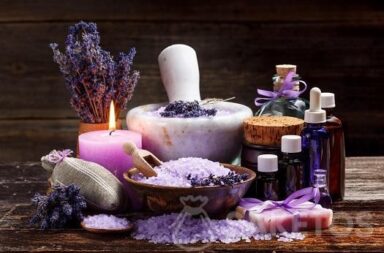Would you like to make your own glycerine soap? Great! We’ve prepared simple step-by-step instructions! Check out our tried and tested recipe.
See for yourself that making home-made soap is really easy! Find out how to make DIY glycerine soap.
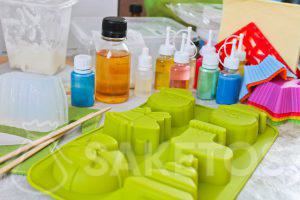
Home-made soaps – how to make them?
Glycerine soap recipe
We’ve created a simple recipe for glycerine soap that’s tried and tested. Let’s do it together!
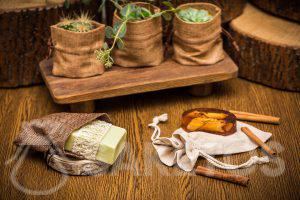
Eco-friendly bags for hand-made soap
Let’s start by preparing the ingredients! What do you need to make your first soap?
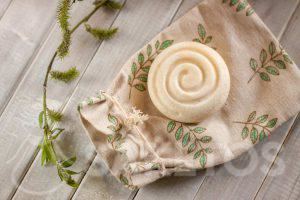
Less-waste packaging for eco soap – a printed linen bag
Main ingredients:
- The most important ingredient is a ready-made glycerine soap base (from vegetable glycerine). You can use either crystal (clear) or cream (white) bases.
- Optional additives: dye, essential oils, care oils, e.g. with vitamin E, and decorative additives. Don’t be afraid to experiment. You can try some crazy ideas here! The additional ingredients will make your soaps truly unique.
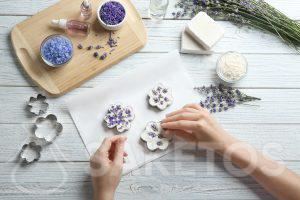
Decorating home-made soap
Accessories:
- grater,
- weight,
- accessories needed for the water bath: a vessel for dissolving the base, a vessel with water, access to a burner,
- moulds (we recommend silicone ones, especially for the beginning of your experience as a soap-maker),
- alcohol and a spray bottle,
- a wooden stirring stick.
Glycerine soaps – step-by-step instructions
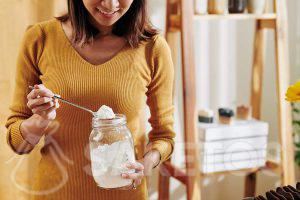
DIY soap – instructions
- Grate and measure the amount of glycerine base needed for the mould (add a little more as some of the product will remain on the mould’s walls). Not sure how much base you need for a particular mould? To simplify things a bit, let’s assume that 1g of the base is equivalent to 1ml of water. You can easily measure how many grams or millilitres of water fit into the mould you chose.
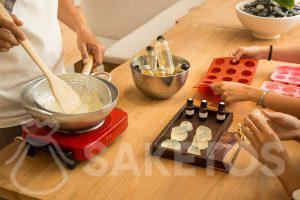
Melting the soap base in the water bath
- Chips are a good solution for beginners. You obtain them by rubbing off the glycerine base. Place the diced base in the water bath. The melting time will vary depending on the specific base type and amount. Prepare it according to the manufacturer’s instructions on the package. Make sure the glycerine doesn’t start boiling.
- Glycerine base can also be melted in a microwave oven.
- When the base melts down, add to it the complementary ingredients of your choice – dyes and oils (they will give provide a scent but also determine additional properties of your soap).
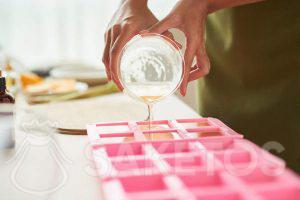
Pour the ready mixture into the moulds. The silicone ones will be the most convenient.
- Now it’s time to pour the melted mixture into the moulds. If bubbles appear on the surface, spray it with rectified alcohol (96%).
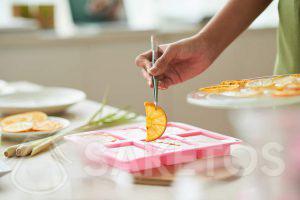
Decorating soaps
- Want to decorate your soaps? You can do it by embedding dried fruit, flowers, or coffee beans into your soap.
The cooling time depends on the type of base and the thickness of the soap. You can speed up the process by putting the mould in the fridge after pre-cooling it.
Pros of glycerine soaps
Glycerine soaps can be works of art! However, it’s good to know that beauty isn’t their only asset. Discover the other benefits of home-made soap.
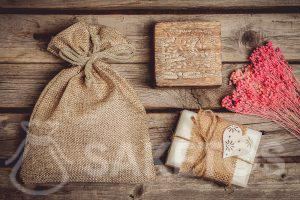
White natural soap can be decorated and wrapped as a gift in a jute bag.
Why replace cleaning products bought at a chemist’s with home-made glycerine soap?
- First, the composition of glycerine base is natural and its PH is close to the skin’s natural PH (it has a moisturising and soothing effect and doesn’t cause allergies). If you analyse the compositions of popular soap bars and shower gels, you’ll certainly be horrified.
- Second, home-made soap is cheaper than bars available in stores (the price comparison concerns products made of raw materials of similar quality and properties).
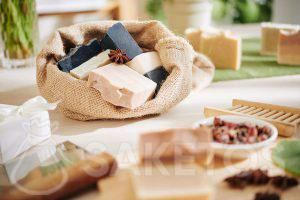
Natural DIY soaps – ecological and safe for the skin
- It’s personalized – you decide on its shape, scent, and other properties by applying ingredients of your choice. By adding nut pieces or oatmeal, you’ll make an organic mechanical scrub.
- Making it always means great fun for children and adults alike.
What properties do glycerin soaps have?
Preparing glycerin soap on your own is not only great fun but also a way to take care of your health and the environment. Glycerin, being the main ingredient in such products, is commonly found in natural cosmetics. The recipe for glycerin soap is not complicated and does not require much effort. This way, we obtain a product that effectively cares for our skin and provides moisture. Glycerin stands out for its hygroscopic and softening properties. The substance itself is obtained from vegetable fats. Another advantage is its gentle formula and neutral pH.
Glycerin soaps are entirely natural products. If you prepare them yourself, you have full control over what goes inside. Therefore, you don’t have to worry about the presence of dyes, detergents, or other harmful substances that could irritate the skin. Knowing how to make glycerin soap also gives you the opportunity to add valuable oils that further nourish the body. Such products are suitable for almost every skin type, even sensitive ones. The risk of potential allergies is very low.
Regular use of glycerin soap is an excellent way to strengthen the natural hydrolipid barrier. Keep in mind that this barrier can be compromised, for example, through long baths in hot water or hot showers, both of which have a drying effect. Glycerin soaps also contribute to the proper maturation of skin cells. The substance is capable of bringing younger cells from deeper layers to the surface, creating a stronger protective barrier.
Why is it worth trying the glycerin soap recipe?
If you’re wondering how to make glycerin soap and if it’s worth the effort, consider the benefits your skin can gain. Natural ingredients will significantly improve its condition, even providing rejuvenating, smoothing, and firming effects. It’s especially worthwhile to use glycerin soap during the winter months when the skin is particularly susceptible to dryness and irritation. Due to glycerin’s hygroscopic properties, it can absorb and retain water molecules, offering additional protection against harmful external factors. It’s a way to effectively cleanse the skin without compromising its protective barrier.
After bathing with glycerin soap, your body will be perfectly nurtured and clean. Additionally, glycerin has the ability to accelerate the healing process of wounds and regulate skin exfoliation. The substance is primarily composed of small particles that can penetrate into deeper layers of the skin, facilitating the transport of other active ingredients. It can enhance the effects of oils and other substances you may have enriched the soap with.
The recipe for glycerin soap allows you to prepare several products at once. This stock will come in handy, especially if you plan to use them every day. After use, the skin will be elastic and smooth, regaining a healthy appearance and glow.
DIY soaps – creative play with your child
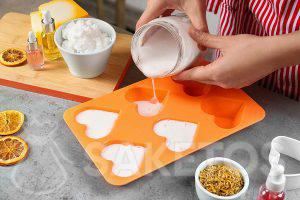
Home-made heart-shaped soaps
Making glycerine soap is also a great way to spend time with your kid. It’s great and creative fun (find out more: Home-made soaps step by step – creative play with your child). If you use a ready-made glycerine base, the only thing left to do is forming and decorating, which means a whale of a time. We’re sure children will enjoy making home-made soaps.
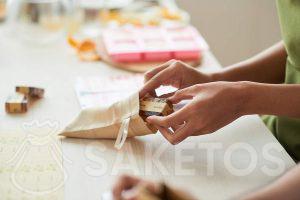
Natural soap in a fabric bag
Home-made soap – original DIY gifts
Home-made soaps are a great idea for an original and practical gift. Once you’ve made your own glycerine soap, it’s time to find the right packaging for it.
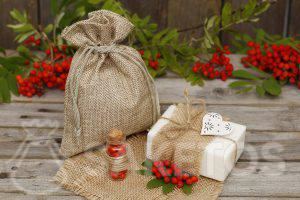
Natural cosmetics such as hand-made soap look great wrapped in a jute bag.
See for yourself that soap bars tied with ribbon or raffia look absolutely great! All you need to do is put them in a decorative box and there you are – the beautiful gift is ready!

Soap in a pink organza bag
Finally, let us remind you that as far as decorative gift wrapping goes, fabric bags are perfect – find out more about our soap packaging.
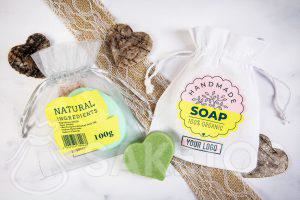
A bag with a logo as packaging for handmade soaps


